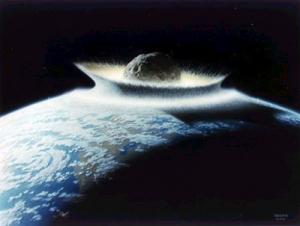The B612 Foundation continues to examine the danger of near-Earth objects (NEOs). As noted earlier in these pages, B612 points to the continuing evidence for asteroid and comet impacts and their role in shaping the planet’s history; the much discussed demise of the dinosaurs, due to a likely asteroid strike in the Yucatan, is but one of the instances where the planetary ecology has been altered. We know that the Earth orbits in a swarm of near-Earth asteroids, with a probability of collision in this century that the Foundation pegs at an unacceptably high 2 percent.
Given these concerns, and the possible dangers posed by the object called NEO 99942 Apophis, the Foundation has engaged in a dialogue with NASA about possible missions to this asteroid. Apophis (also known as 2004 MN4) is on course for a near-miss in 2029 , with the 400-meter asteroid approaching to within 32,000 kilometers. What happens afterwards as the near-miss itself disrupts the orbit of this object remains a concern; we may be looking at an uncomfortably close 2036 encounter.
 The B612 Foundation has suggested placing a radio transponder on the asteroid to plot its orbit more accurately. The complete communication between the Foundation and NASA on this subject is now available on its Web site. NASA concluded that a transponder mission and a follow-up deflection mission, if required, could be performed after the 2013 radar acquisition of Apophis, and that no transponder mission was therefore required at this time. A deflection mission decision would have to be made by 2021. By that time, Arecibo radar may well have determined whether deflection is necessary without the need for the earlier mission, although the agency does not completely rule out earlier missions given the growing interest in near-Earth objects and the opportunity this one presents for study.
The B612 Foundation has suggested placing a radio transponder on the asteroid to plot its orbit more accurately. The complete communication between the Foundation and NASA on this subject is now available on its Web site. NASA concluded that a transponder mission and a follow-up deflection mission, if required, could be performed after the 2013 radar acquisition of Apophis, and that no transponder mission was therefore required at this time. A deflection mission decision would have to be made by 2021. By that time, Arecibo radar may well have determined whether deflection is necessary without the need for the earlier mission, although the agency does not completely rule out earlier missions given the growing interest in near-Earth objects and the opportunity this one presents for study.
Image: A scenario to avoid, and a major reason why deep space technologies to prevent such events should be a priority. Credit: European Space Agency.
These documents make for fascinating reading, especially the Foundation’s analysis of Apophis as a highly unusual NEO — its Earth-like orbit means that a relatively inexpensive deflection technique should suffice to protect Earth from a 2036 impact if such a mission is ever needed. Apophis is not typical of the NEO impact threat, however, and a typical NEO impact scenario would require a more sophisticated mission. Out of all this come three recommendations:
Centauri Dreams has long advocated an awareness of the danger of near-Earth objects and their devastating potential in the event of an impact. Asteroid and cometary impacts are a key driver for our push into the outer Solar System, for the sooner we can get to an object, the more time we will have to deflect it from a potential encounter with Earth. Not all space science occurs because of curiosity; some occurs out of self-defense, and the development of superior propulsion techniques cannot be looked upon as a luxury but a matter of planetary survival.

